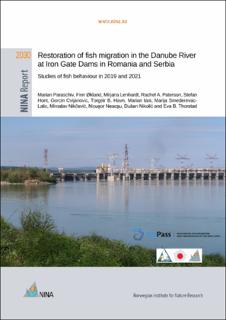| dc.description.abstract | Paraschiv, M., Økland, F., Lenhardt, M., Paterson, R.A., Hont, S., Cvijanovic, G., Havn, T.B., Iani, M., Smederevac-Lalic, M., Nikčević, M., Neacșu, N., Nikolić, D. & Thorstad, E.B. 2021. Restoration of fish migration in the Danube River at Iron Gate Dams in Romania and Serbia. Studies of fish behaviour in 2019 and 2021. NINA Report 2030: 1-36.
The Iron Gate hydropower and navigation system is one of the largest river engineering projects in Europe, with the dams built to provide hydropower and facilitate navigation along the Danube. The Iron Gate Dam I was completed in 1972 and Iron Gate Dam II in 1984. The border between Romania and Serbia follows the Danube in this area, and the two countries share both dams.
Before the construction of the dams, fish were able to migrate from the Black Sea to the upper parts of the Danube and its tributaries. The dams blocked upstream fish migration, and no fish passes have been constructed. Constructing fish passes at the Iron Gate Dams would open up 960 km of the Danube River to the Gabčíkovo Dam (Slovakia) to upstream migrating sturgeon and other fishes, and in addition access to numerous tributaries.
Well-functioning fish passes require that migrating fish are able to find and use the entrance, and thereafter move through the entire fish pass. The entrances need to be located in areas where migrating fish seek a passable route past the dam. To establish functional fish passes is particularly challenging at large dams where there is a long distance between the river banks and large areas where the fish can migrate and aggregate.
Results from a feasibility study of the behaviour of asp, barbel, common carp, common nase, Pontic shad and vimba bream in autumn 2019 and spring 2021 are presented in this report, as a step towards identifying suitable areas for fish pass entrances at the Iron Gate Dams. The specific aims were to examine behaviour and distribution of fish downstream of the Iron Gate Dam II and in the Gogosu branch, movements in the reservoir between the Iron Gate Dam I and Iron Gate Dam II, and behaviour and distribution of fish downstream of the Iron Gate Dam I, if tagged fish would reach this far.
The study was performed by tagging fish with acoustic transmitters and releasing them downstream and upstream of Iron Gate Dam II. The movements of tagged fish were recorded by deploying receivers at strategic places in the river. Tagged fish were automatically recorded when they were within the detection range of the receivers.
A total of 185 fish were tagged; 61 in autumn 2019 and 124 in spring 2021. The most common species among the tagged fish were vimba bream and common nase, followed by barbel and asp.
Vimba bream, common nase, barbel and asp are known to be migratory species, which can perform long-distance movements. This was confirmed also for our study area, with many tagged individuals performing extensive movements, both below the Iron Gate II dam, in the Gogosu branch and in the reservoir. Several barbel, common nase and vimba bream moved upstream through the entire reservoir to the Iron Gate I dam, which was 76 km from the release site in the lower part of the reservoir. Barbel and vimba bream were the two species showing the most extensive movements. The study also confirmed that there is large individual variation in movement strategies and behaviour within these species.
The detailed behaviour of the fish when approaching the Iron Gate II and Iron Gate I dams was studied by deploying several receivers with different detection ranges in the areas below the dams. The fish showed great individual variation in where they approached the dams, and most of the individuals were recorded by receivers on both sides of the river. Hence, a preference for moving along one particular side of the river was not identified for any of the species. Studies of detailed behaviour of tagged fish can only be as fine-scaled as the receiver deployment allows.
In the present study, a relatively limited number of acoustic receivers was used, limiting the analysis of detailed behaviour below the dams. Further studies will be performed to increase the information of the detailed fish behaviour below the dams. | en_US |
